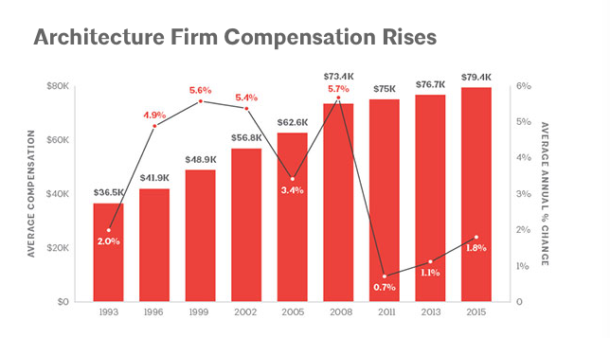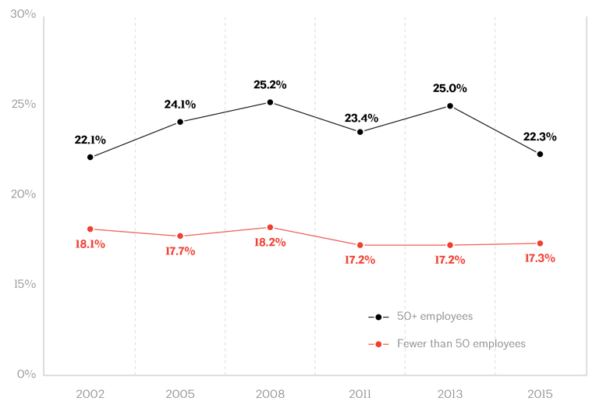According the the AIA Economics & Market Research Team, U.S. architecture firms are still recovering from the economic effects of the Great Recession.
In the past few years reports through U.S. Census Bureau have indicated that revenue at architecture firms increased by $11 billion between 2010 and 2014, making up for over three-quarters of the decline experienced by the profession between 2008 and 2010. Employment at these firms, however, has not held up nearly as well: Less than 20 percent of the payroll positions lost during the recession having been recovered as of the end of 2014, according to the U.S. Department of Labor.
Looking at the last two years across the board, business conditions at architecture firms have generally been positive. The American Institute of Architects’ Architecture Billings Index (ABI) averaged 52.1 in 2013 and 52.2 in 2014. Since a reading of 50.0 indicates stable billings activity, these scores signify healthy growth. New project activity coming into architecture firms over this period suggests that architecture firm revenue will continue to grow. The AIA’s Design Contracts Index—which measures new project work—fared even better than billings, with index averages of 52.8 in 2013 and 53.5 in 2014.

01 – Relatively healthy scores in the AIA’s Architecture Billings Index suggest that further compensation increases are likely. (image: AIA. All rights reserved.)
Architecture positions demonstrate increased compensation with gains beginning to accelerate after several years of slow-going improvement at best. Compensation across the profession increased an average of 1.8 percent per year over the 2013–2014 period, with growth occurring in every architectural staff category. While modest, these compensation increases have outpaced the low overall levels of inflation in the economy, thereby producing real compensation gains for employees across the profession.
With market conditions continuing to improve at architecture firms, and firms continuing to add positions, compensation acceleration is possible. More than half of firms with 20 or more employees reported offering sign-on bonuses in 2014 to attract new employees. Many firms are also boosting their benefits—or increasing the firm contribution for their existing benefits—in an effort to compete for new employees and retain current staff.
MORE: AIA offers free Salary Calculator that works across positions and region of the country
Average compensation for architectural staff
Median compensation for architectural staff positions hovers just under $80,000 at the beginning of 2015, up about 3.5 percent from early 2013 levels, or 1.75 percent per year. This pace of increase is well below averages for the profession over the past two decades, when annual compensation increases were generally in the range of 4 percent to 5 percent. Even so, compensation increases are up from the period 2008 to 2013, when they averaged less than one percent per year. Relatively healthy scores in the AIA’s ABI suggest that further compensation increases are likely.
Besides, the architecture profession has mainly avoided recent concerns of income disparities and income inequality. As of early 2015, the average compensation of $192,200 for a CEO position at architecture firms was only 4.5 times the average compensation for an Intern 1 position of $42,900. Even in 2008, at the height of profitability and compensation growth at architecture firms, the ratio of average CEO compensation to an Intern 1 position was just 5:2. This ratio fell to 4:2 in 2011—when business conditions were near the bottom for this past cycle—before climbing to 4:5 in 2013 and remaining at that level as of early 2015.

02 – More senior positions typically have a much smaller share of compensation as base pay, falling to under 70 percent for CEO/president positions on average. (image: AIA, All rights reserved.)
While compensation gains for senior and junior positions at architecture firms have moved roughly in tandem in recent years, the composition of this compensation is different. (see chart above).
Higher compensation by larger firms
As a whole, larger firms tend to offer higher compensation levels on average, and are also more likely to offer a more comprehensive benefits package to their employees. Firms with 50 or more employees are more likely to offer medical and dental coverage for employees and their dependents. Larger firms are also likely to offer more vacation, sick, and personal time than smaller firms.

03 – The value of benefits as a share of base pay increased at larger firms over the past decade and then fell back in recent years. (image: AIA, All rights reserved.)
As a result, employees at larger firms have a better share of base pay offered to them as opposed to smaller firms. For professional staff, the value of benefits averaged just over 17 percent of employee base pay for firms with fewer than 50 employees in early 2015 and was almost five percentage points higher (22.3 percent) at firms with 50 or more employees.
For more information on the 2015 AIA Compensation Survey Report, including links to purchase the full, regional, and metro area versions of the report, please visit www.aia.org/compensation.



Reader Comments
AIA Architect reports that earnings for architecture positions has followed with gains beginning to accelerate after…https://t.co/cvnmbyDmlt
AIA Architect reports that earnings for architecture positions has followed with gains beginning to accelerate after…https://t.co/cvnmbyDmlt
Comments are closed.